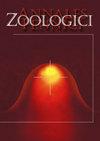重述双翅蝗科的有丝分裂基因组、基因重排和系统发育
IF 0.9
4区 生物学
Q4 ECOLOGY
引用次数: 4
摘要
稻田蛙(Fejervarya multistata)属于蛙科,是一种广泛分布于亚洲温带和热带的物种。本研究对多孢镰刀菌线粒体全基因组进行了测序。有丝分裂基因组大小为17677bp,由13个蛋白质编码基因(PCG)、23个转移RNA(tRNA)基因、两个核糖体RNA(rRNA)基因和一个非编码控制区(D-loop)组成。与其他脊椎动物一样,该物种的大多数线粒体基因都编码在重链(H)上,除了ND6和八个tRNA基因编码在轻链(L)上。总的碱基组成包含28.03%A、29.90%T、26.91%C和15.16%G。Fejervarya和相关物种控制区的排列表现出高遗传变异性和丰富的A+T含量。此外,我们发现tRNA-Leu2重排发生在多孢镰刀菌线粒体基因组中的LTPF基因簇中,导致了一种新的排列(T-PL-F)。tRNA-Gln和ND2之间存在tRNA-Met基因的串联重复,两个基因的相似率达到74.6%。通过重建系统发育树(ML和BI)分析了13个PCG的核苷酸序列的系统发育关系。结果表明,多孢镰刀菌与林氏镰刀菌的亲缘关系比与Canclivora和manoharani的亲缘关系更密切,后者表现出新的基因重排(ND6-tRNA-Glu-Cytb-D-loop-ND5-tRNA-Thr-tRNA-Pro-tRNA-Leu-tRNA-Phe)。研究结果表明,在盐城发现的林蛙和在莫家、三台、吉安发现的多孢蛙可能是同种。该研究为今后进一步研究多孢镰刀菌及其相关种的系统发育关系和分类地位提供了重要参考。本文章由计算机程序翻译,如有差异,请以英文原文为准。
Mitogenome, Gene Rearrangement and Phylogeny of Dicroglossidae Revisited
The paddy frog (Fejervarya multistriata) belonging to the family Dicroglossidae, is a species widely distributed in temperate and tropical Asia. In this study, the complete mitochondrial genome of F. multistriata was sequenced. The mitogenome was 17 677 bp in size, consisting of 13 protein-coding genes (PCGs), 23 transfer RNA (tRNA) genes, two ribosomal RNA (rRNA) genes, and a non-coding control region (D-loop). Like in other vertebrates, most mitochondrial genes of the species are encoded on the heavy (H) strand, except for ND6 and eight tRNA genes which are encoded on the light (L) strand. The overall base composition contained 28.03% A, 29.90% T, 26.91% C and 15.16% G. The alignment of the Fejervarya and related species' control regions exhibited high genetic variability and rich A + T content. In addition, we found that the tRNA-Leu2 rearrangement occurred in the LTPF gene cluster in the mitochondrial genome of the F. multistriata, resulting in a new arrangement (T-PL-F). There was a tandem duplication of the tRNA-Met gene between tRNA-Gln and ND2, and the similarity rate of the two genes reached 74.6%. The phylogenetic relationships based on nucleotide sequences of 13 PCGs was analysed by re-establishing phylogenetic trees (ML and BI). The results indicated that F. multistriata was more closely related to F. limnocharis than to F. cancrivora and F. manoharani, the two latter showing a new gene rearrangement (ND6-tRNA-Glu-Cytb-D-loop-ND5-tRNA-Thr-tRNA-Pro-tRNA-Leu-tRNA-Phe). Our results indicate that F. limnocharis sample found in Yancheng, and F. multistriata from Mojia, Santai and Ji'an, are possible conspecifics. This study on the mitochondrial genome of F. multistriata provides an important reference for the future studies on phylogenetic relationship and the taxonomic status of Fejervarya and related Dicroglossidae species.
求助全文
通过发布文献求助,成功后即可免费获取论文全文。
去求助
来源期刊

Annales Zoologici Fennici
生物-动物学
CiteScore
2.40
自引率
14.30%
发文量
10
审稿时长
>12 weeks
期刊介绍:
Annales Zoologici Fennici publishes mainly original research reports, but also in-depth reviews and commentaries on all aspects of animal ecology and evolution, and fields related to them. Our aim is to promote papers which focus on the interactions among various components in the past and present environments by using integrative and cross-disciplinary approaches. This may be achieved by employing tools from different fields of research, such as (but not restricted to):
ecology and paleoecology,
molecular ecology and phylogeography,
conservation biology, human-induced contemporary evolution and wildlife management,
animal behaviour and interactions (including recognition systems and mechanisms),
paleontology (except systematics and taxonomy) and evolution,
bioenergetics.
 求助内容:
求助内容: 应助结果提醒方式:
应助结果提醒方式:


